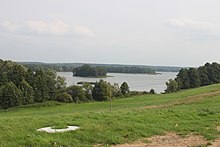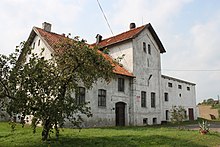Zalesie (Dźwierzuty)
| Zalesie | ||
|---|---|---|

|
|
|
| Basic data | ||
| State : | Poland | |
| Voivodeship : | Warmia-Masuria | |
| Powiat : | Szczytno | |
| Gmina : | Dźwierzuty | |
| Geographic location : | 53 ° 43 ' N , 21 ° 4' E | |
| Residents : | ||
| Postal code : | 12-120 | |
| Telephone code : | (+48) 89 | |
| License plate : | NSZ | |
| Economy and Transport | ||
| Street : | Kałęczyn / ext. 600 → Zalesie | |
| Rail route : | no rail connection | |
| Next international airport : | Danzig | |
Zalesie ( German Salleschen , also: Saleschen, 1938 to 1945 Ingelheim ) is a place in the Polish Warmian-Masurian Voivodeship . He belongs to the Gmina Dźwierzuty (rural community Mensguth ) in the Powiat Szczycieński ( Ortelsburg district ).
Geographical location
Zalesie is located on the northwest bank of the Rheinswein Lake ( Jezioro Rańskie in Polish ) in the southern center of the Warmian-Masurian Voivodeship , 17 kilometers north of the district town of Szczytno ( German Ortelsburg ).
history
Local history
The Vorwerk on the Rheinsweiner See was spun off from a former large estate in Rheinswein ( Rańsk in Polish ) and became an independent estate as Gut Salleschen (until 1881 also "Saleschen").
In 1874 was Salle's office Village and thus its name to an administrative district in the county Ortelsburg in Administrative district Königsberg (1905: Administrative district Allenstein ) in the Prussian province of East Prussia . Eleven villages were initially incorporated. The manor district of Salleschen had 123 inhabitants in 1910. On the basis of the provisions of the Versailles Treaty , the population in the Allenstein voting area , to which Salleschen belonged, voted on July 11, 1920 to continue to belong to East Prussia (and thus to Germany) or to join Poland ex. In Salleschen, 89 people voted to stay with East Prussia, while Poland did not vote.
In 1929 Salleschen was incorporated into the neighboring town of Kallenczin (1938 to 1945 Kallenau , Polish: Kałęczyn ) and on June 3 - officially confirmed on July 16 - 1938 renamed "Ingelheim". A few months later - on November 15, 1938 - the Salleschen district, which was now called "Rheinswein district", was also renamed.
When the whole of southern East Prussia was transferred to Poland in 1945 as a result of the war , Salleschen resp. Ingelheim affected. The place received the Polish form of the name "Zalesie" and is now a place in the network of the rural community Dźwierzuty (Mensguth) in the powiat Szczycieński ( Ortelsburg district ), until 1998 the Olsztyn Voivodeship , since then it belongs to the Warmia-Masurian Voivodeship .
Salleschen district (1874–1938)
Originally there were eleven places in the newly established Salleschen (Saleschen) district. In the end there were six:
| German name | Changed name (1938 to 1945) |
Polish name | Remarks |
|---|---|---|---|
| Noble Mingfen | Miętkie | before 1898 in the rural community Mingfen incorporated | |
| Old Marxöwen | Markshöfen | Marksewo | 1876 in the rural community Marxöwen incorporated |
| Heering | Śledzie | incorporated into Rheinswein around 1900 | |
| Jellinowen | Gellen (East Pr.) | Jeleniowo | |
| Kallenczin | Kallenau | Kałęczyn | |
| Royal Mingfen | before 1898 in the rural community Mingfen incorporated | ||
| New Marxöwen | 1876 in the rural community Marxöwen incorporated | ||
| Rheinswein (village) | Rańsk | ||
| Rhine wine (good) | 1928 incorporated into the rural community of Rheinswein | ||
| Salleschen (Saleschen) | Ingelheim | Zalesie | 1928 incorporated into the rural community of Kallenczin |
| Zimnavodda |
(from 1933 :) Hirschthal |
Zimna Woda |
When the district became the "Rheinswein district", it included: Gellen (Ostpr.), Hirschthal, Kallenau, Markshöfen, Mingfen and Rheinswein.
Gut Salleschen / Ingelheim
Estates
In 1717 Salleschen belonged to Georg Christoph Küchmeister von Sternberg . After that, the owners changed frequently. At the beginning of the 19th century the property went to the von Massenbach family . After 1910, the Prussian state built a domain here that was leased. The last domain leaseholder was Paul Müller .
manor
Edmund von Massenbach , a landowner born in Salleschen in 1830 and bearing the title of baron from 1880, had the manor house built in the middle of the 19th century. An original cast iron staircase with plant motifs and geometric designs leads to the main entrance. The building is now in good shape and is privately owned.
Manor park
The park was designed by the garden architect Johann Larass in 1865 . It is still in good condition today. The various views of the manor house and the lake are impressive.
church
Until 1945 Salleschen resp. Ingelheim parish in the Protestant Church of Rheinswein in the church province of East Prussia of the Church of the Old Prussian Union and in the Catholic Church of Mensguth in what was then the Diocese of Warmia .
Today, on the Catholic side, Zalesie belongs to the parish in Targowo (Theerwisch) in what is now the Archdiocese of Warmia , and on the Protestant side to the church in Rańsk , which is now a subsidiary church of the parish in Szczytno in the diocese of Masuria of the Evangelical-Augsburg Church in Poland .
traffic
Zalesie can be reached from Kałęczyn (Kallenczin , 1938 to 1945 Kallenau) on Voivodship Road 600 via a dead end . There is no connection to rail traffic .
Web links
Individual evidence
- ↑ Polish Postal Code Directory 2013, p. 1583
- ^ Dietrich Lange, Geographical Register of Places East Prussia (2005): Ingelheim
- ↑ a b c Zalesie - Salleschen / Ingelheim at ostpreussen.net
- ↑ a b c Rolf Jehke, Saleschen / Salleschen / Rheinswein district
- ^ Uli Schubert, community directory, Ortelsburg district
- ↑ Herbert Marzian , Csaba Kenez : self-determination for East Germany. Documentation on the 50th anniversary of the East and West Prussian referendum on July 11, 1920. Editor: Göttinger Arbeitskreis , 1970, p. 98
- ↑ a b Kallenczin / Kallenau at the Ortelsburg district community
- ↑ Walther Hubatsch , History of the Protestant Church of East Prussia , Volume 3 Documents , Göttingen 1968, p. 497
- ↑ Mensguth Catholic parish




